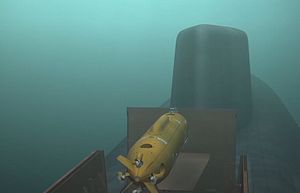Russia has reportedly commenced sea trials of its ultimate doomsday weapon, a nuclear-capable underwater vehicle (UUV), dubbed ‘Poseidon,’ purportedly designed to deliver a 2-megaton nuclear warhead to destroy naval bases, carrier strike groups, and entire coastal cities by triggering a radioactive Tsunami wave.
The sea trials of the “Poseidon” began last week and are primarily focused on the UUVs guidance system and underwater operations in autonomous mode. Work on the “Poseidon” is reportedly progressing according to schedule, the Russian Ministry of Defense (MoD) said in a July 19 statement.
The “Poseidon,” also known under Ocean Multipurpose System Status-6 or “Kanyon” by the U.S. intelligence community, “is a new intercontinental, nuclear armed, nuclear-powered, undersea autonomous torpedo,” according to the 2018 U.S. Nuclear Posture Review. The UUV is thought to have been developed in reaction to the increasing sophistication of U.S. ballistic missile defense systems.
It appears to be a weapon of last resort to strengthen Russia’s nuclear deterrence posture vis-à-vis the United States and NATO. Torpedoes equipped with a nuclear propulsion system and fitted with a nuclear warhead for use over long distances were first conceived in the Soviet Union back in the 1950s.
Much speculation, a lot of it almost certainly widely exaggerated, has taken place over the precise capabilities of the ‘Poseidon’ UUV. According to a Russian defense industry source quoted by TASS news agency, “it will be possible to mount various nuclear charges on the ‘torpedo’ of the Poseidon multipurpose seaborne system, with the thermonuclear single warhead similar to the ‘Avangard’ charge to have the maximum capacity of up to 2 megatons in TNT equivalent.”
The nuclear-capable UUV has “primarily designed to destroy reinforced naval bases of a potential enemy,” the source added in May of this year. Despite having been officially revealed to the public in March, the Russian MoD has so far not publicly commented on the UUVs nuclear payload.
Earlier last week, the MoD said in a statement that it considers the “Poseidon” to be 100 percent invulnerable to any countermeasures. The drone’s unique capabilities will enable the Russian Navy to fight carrier- and surface action groups (…) and strike coastal infrastructure facilities at an intercontinental distance.”
While the MoD did not reveal details regarding the UUVs sea trials it is likely that the “Poseidon” will be launched from a B-90 Sarov-class Project 20120 diesel-electric submarine—the only submarine of its class currently in service with the Russian Navy specifically designed to serve as a testing platform for new military hardware.
The existence of the Poseidon program was first revealed by the Western media in September 2015 (See: “Is Russia Building a Top-Secret Nuclear-Armed Underwater Drone?”). A Russian state-run television station aired footage showing a classified presentation slide of the long-range nuclear-capable UUV in November of the same year. As I reported at the time:
(The slide referred to the torpedo as “self-propelled underwater vehicle” with a range of “up to 10,000 km” (6,200 miles) capable of operation in depths “up to 1,000 m” (3,300 feet). According to Russian media reports cited by the BBC, the torpedo can travel at 100 knots (185km/h; 115mph) avoiding all “acoustic tracking devices and other traps.”
With a diameter of 1 meter, the “robotic mini-submarine” (or torpedo) would apparently be launched by either a Project 09852 sub – based on the 949A Oscar-class boat—or a Project 09851 submarine, laid down in December 2012 and July 2014 respectively and with unknown completion dates.
Once completed, both submarines will have the capability to carry smaller [UUVs]: The Project 09852 sub will be able to carry up to six torpedoes, whereas a Project 09851 boat will be capable of fitting up to four UUVs.
Based on information on the slide, the new weapon could be equipped with a thermonuclear warhead with a layer of cobalt-59, “which on detonation would be transmuted into highly radioactive cobalt-60 with a half-life longer than five years,” the BBC reports. A prototype is slated to be built by 2019 with first tests occurring sometime around 2019-2020, according to the paper.
Apparently, sea trials have kicked off ahead of schedule, although it remains unclear to what degree the UUV will be capable of autonomous operations over intercontinental distances given the multitude of technical challenges that likely will still need to be overcome. Various analysts have speculated that the ‘Poseidon’ UUV will not move beyond the prototype stage as it is principally designed for political purposes to initiate talks about anti-ballistic missile defenses with the United States.
According to a March 2018 statement by U.S. Defense Secretary James Mattis, the nuclear-capable UUV, “does not change at all the strategic balance,” between Russia and the United States.
































